European Forest Reserves Initiative (EuFoRIa)
2019 - 2029
Contents

The EuFoRIa network was founded in 2019 to enhance the visibility and exploit the potential of the large number of long-term monitoring plots in European primeval forests and forest reserves. These plots and the data collected on them for multiple decades and often >50 years have a high potential for increasing our understanding of forest dynamics in a rapidly changing environment, and to provide the basis for better projections of future forest dynamics.

Goals ¶
The goals of EuFoRIa are to:
- Foster networking among the researchers studying primeval forests and forest reserves using long-term data series of monitoring plots
- Get an overview of the existing data (such as number of plots, plot area, number of repeated measurements, environmental gradient covered)
- Identify research questions to which analyses of existing data could provide answers, discuss suitable approaches, analyse data and publish the results, building on the strengths of the plot network
- Foster exchange about inventory methods (design, variables, field procedures, data cleaning) and their long-term documentation
- Identify common interests in future research as a basis for new collaborations
- Work towards getting the network activities funded, e.g. via a COST Action or a Horizon Europe project
Data set ¶
We compiled metadata on the forest inventories carried out on hundreds of permanent plots in primeval forests and forest reserves across Europe, with a focus to date on temperate forests. This includes data on forest type, species composition, deadwood amounts, regeneration surveys and biodiversity data such as the presence of habitat structures, fungi, birds and insects. Additionally, there is a compilation of associated data from remote sensing, and on soil and site characteristics as well as dendrochronology data.
In the framework of two projects focusing on demographic rates, we compiled a large data set of 5722 survey plots covering 8858 ha of forests and a time span from 1936 to 2020. It includes 1.2 Mio records of around 0.5 Mio trees. All permanent plots included in the data set are located in primeval forests or in forests that have been unmanaged for at least one decade, but in most cases many decades to centuries.
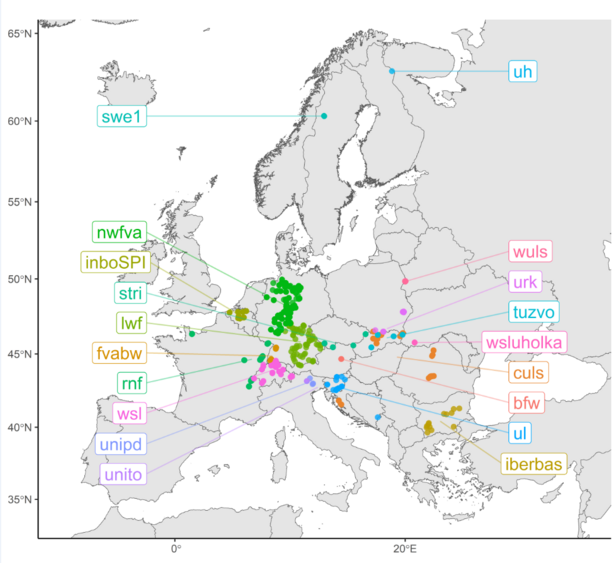
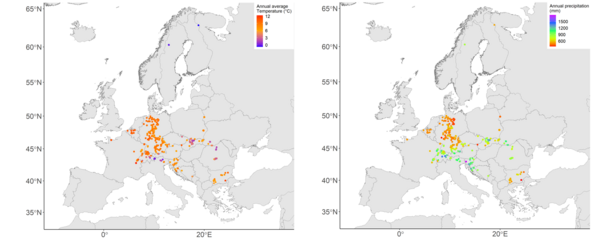
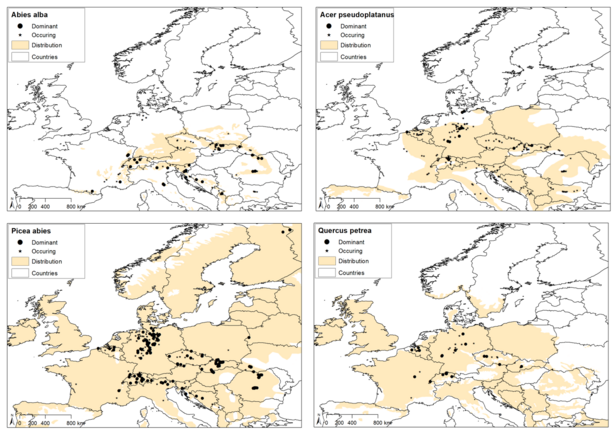
Projects ¶
Since the foundation of the network in 2019, four dedicated research projects have been started and are still going on.
Snag longevity in European forest reserves
We analyse snag dynamics over time and across different environmental gradients, forest types and tree variables using the long-term inventories of EuFoRIa. We investigate how long snags remain standing and thus how long they will effectively fulfil their expected ecological functions such as providing habitat to many species or contributing to forest carbon stocks in the form of aboveground dead biomass.
Lead: Olalla Díaz-Yáñez, Tomáš Přívětivý, Kamil Kral and Harald Bugmann
Demographic rates: Mortality
The goal of this project is to study demographic rates with a focus on mortality. We analyse the variation of mortality rates of European tree species across different environments. We aim to identify how annual tree mortality rates have changed over time and what the drivers of these changes are. We distinguish between the contribution of density-dependent and disturbance-mediated mortality.
Lead: Jokin Idoate Lacasia, Peter Brang and Martina Hobi
Demographic rates: Regeneration
In this project we analyse demographic rates in the EuFoRIa network, with a focus on regeneration. Specifically, we are interested in their variation across a variety of environments. We elucidate how recruitment rates change after disturbances and if in the context of climate change the recruitment rates of drought-adapted tree species have increased already. Furthermore, we study legacy effects, e.g. management, and how they affect recruitment rates in natural forests.
Lead: Yannek Käber and Harald Bugmann
Biomass dynamics
We use the long-term datasetsof EuFoRIa to investigate biomass dynamics of unmanaged forests. We test four hypotheses: (1) Biomass increases in-re-wilded forests towards a site- and tree species-specific carrying capacity. (2) Initially, biomass dynamics show an overshoot of the carrying capacity followed by a decreasing phase. (3) This wave-like pattern tends to flatten in the course of development. (4) Disturbances trigger short-term increases of growth rates but in the long-term reduce potential biomass levels at the landscape scale.
Lead: Peter Meyer and Rouven Nagel
Members ¶
The EuFoRIa working group includes 26 member institutions from 19 European countries.
| Country | Institute |
|---|---|
| Austria | Federal Research and Training Centre for Forests, Natural Hazards and Landscape |
| Belgium | Research Institute for Nature and Forest |
| Bulgaria | Bulgarian Academy of Sciences, Institute of Biodiversity and Ecosystem Research, Sofia |
| Croatia | University of Zagreb |
| Czech Republic | Silva Tarouca Research Institute, Pruhonice |
| Czech Republic | Czech University of Life Sciences, Prague |
| Czech Republic | Mendel University in Brno |
| Czech Republic | Sumava National Park |
| Denmark | University of Copenhagen |
| Finnland | University of Helsinki |
| France | National Research Institute of Science and Technology for Environment and Agriculture, Antony |
| Germany | Northwest German Forest Research Institute, Göttingen |
| Germany | Forest Research Institute of Baden-Württemberg |
| Germany | Technical University Munich |
| Germany | National Park Baverian Forest |
| Germany | National Park Berchtesgaden |
| Germany | Bavarian State Institute of Forestry |
| Hungary | Eötvös Loránd University |
| Italy | University of Padova |
| Italy | University of Tuscia, Viterbo |
| Italy | University of Torino |
| Netherlands | University of Wageningen |
| Poland | Warsaw University of Life Sciences |
| Poland | University of Agriculture in Kraków |
| Romania | University of Suceava |
| Slovakia | Technical University in Zvolen |
| Slovenia | University of Ljubljana |
| Spain | Bioma Forestal |
| Sweden | Swedish University of Agricultural Sciences |
| Switzerland | ETH (Swiss Federal Institute of Technology) Zürich |
| Switzerland | Swiss Federal Institute for Forest, Snow and Landscape Research |
-
Membership: EuFoRIa members are working primarily on forest structure dynamics in strict forest reserves. EuFoRIa started in the year 2019 with 15 researchers and was enlarged in 2020 to a group of about 30 researchers. At the beginning of 2022 EuFoRIa comprised about 40 persons. We will continue to enlarge the size of the group, but slowly so as to guarantee mutual knowledge and trust. Therefore, participation is only possible upon request (to the Steering Group) and by invitation.
-
Steering Group: The EuFoRIa Steering Group (SG) is currently composed of 6 members (Martina Hobi, Harald Bugmann, Alfredo Di Filippo, Kris Vandekerkhove, Thomas Nagel and Kamil Kral). The SG is chaired by Martina Hobi and meets on a regular basis. The SG has the tasks to push EuFoRIa forward, prepare decisions and communicate with the network members.
EuFoRIa Steering group ¶
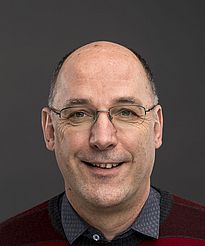
Prof. Harald Bugmann
ETH Zurich, Switzerland

Dr. Kamil Kral
Silva Tarouca Research Institute for Landscape and Ornamental Gardening (VUKOZ), Czech Republic
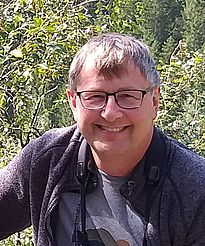
Dr. Kris Vandekerkhove
Research Institute for Nature and Forest (INBO), Belgium
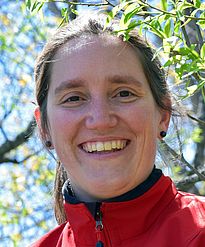
Dr. Martina Hobi
Swiss Federal Research Institute (WSL), Switzerland
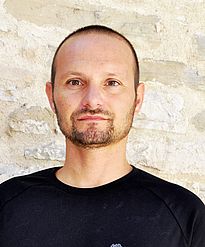
Prof. Alfredo Di Filippo
University of Tuscia, Italy
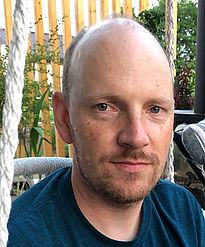
Dr. Thomas Nagel
University of Ljubljana, Slovenia
Events ¶
- Jan 2024, virtual format, one half-day, 50 attendees
- June 2023 Foresta Umbra - Parco Nazionale Gargano, Italy, three days, 17 attendees
- Jan 2023, virtual format, one half-day, 35 attendees
- June 2022, Pruhonice near Prague, Czech Republic, four days, 27 attendees
- Jan 2022, virtual format, one half-day, 33 attendees
- Nov 2020, virtual format, three half-days, 36 attendees
- July 2020, virtual format, three half-days, 16 attendees
- July 2019, Richisau, Switzerland, four days, 16 attendees
Publications ¶
Käber, Y., Bigler, C., HilleRisLambers, J., Hobi, M., Nagel, T. A., Aakala, T., Blaschke, M., Brang, P., Brzeziecki, B., Carrer, M., Cateau, E., Frank, G., Fraver, S., Idoate-Lacasia, J., Holik, J., Kucbel, S., Leyman, A., Meyer, P., Motta, R., … Bugmann, H. (2023). Sheltered or suppressed? Tree regeneration in unmanaged European forests. Journal of Ecology: https://doi.org/10.1111/1365-2745.14181